Experience the trip of a lifetime on an African wildlife safari. See the animals up close and un-caged, including the Big Five in Africa.
This was my first trip to South Africa, and it far exceeded my expectations. I spent three days at the Thornybush Game Lodge and went on six amazing African safari game drives, which are definitely some of my best wildlife experiences. In my wildest dreams, I never thought I would see so many beautiful animals so up-close.
The three days at Thornybush were easily my favorite part of a two week tour in Southern Africa. Although the Rovos Rail luxury train trip to Victoria Falls and another safari in Chobe National Park in Botswana were both really awesome too.
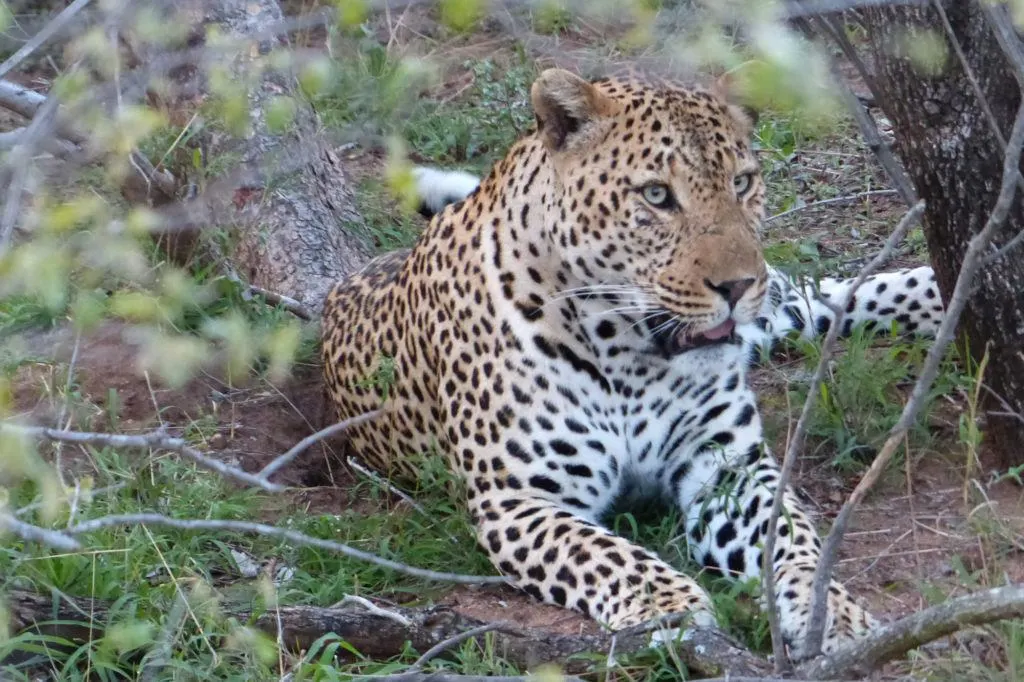
Thornybush Game Drives – One For The Bucket List
The animals are everywhere — they are unfenced, free to roam, and mostly oblivious to us camera wielding tourists. It’s great seeing the Big 5 animals, but there’s so much more. There are many other amazing animals and many reasons to visit South Africa.

Game Drives on an African Wildlife Safari
The game drives begin every morning at 5 AM and every evening around 4 PM and last 2-3 hours. Your transport is a Toyota Land Cruiser driven by a ranger and guided by a tracker. The Land Cruiser is totally open: no doors, no windows, no roof, and no roll bars — you have a completely unobstructed view.
Have you always wanted to go on an African safari? See the best wildlife around the world? Check out these two podcasts and start planning your adventure!
Other drivers came up and saw us there, asked us what we had seen, waited for a few minutes, then left without waiting around to see what would come in next to drink.
The ranger explained that as long as we don’t stand up or put our arms or legs over the side, the animals only see us as one really big unit, and would not attack us. This certainly seemed to be true because we were sometimes just a few feet away from lions, elephants, rhinos, wild dogs, and even a leopard. It was also pretty exciting.

Our guide quite frequently went off-road into the bush over trees and logs and down dry riverbeds. More than once, we were completely surrounded by elephants as they paraded in front of us and circled around behind us. I don’t have the words to explain how incredible this was, and, except for one cranky bull in musk, the elephants ignored us.

What are the Big Five in Africa?
- Lions
- Leopards
- Elephants
- Rhinos
- Cape Buffalo
The term “Big Five” is from the bad old days, when South African animals were frequently hunted for sport; these were the most prestigious to kill because they were the most dangerous to hunt. Although most of us only shoot with cameras now, the term is still used in safari ads. You will see all five in the Thornybush Game Reserve.

What Other Animals Can You See at Thornybush?
In addition to the Big Five in Thornybush, you will see much much more. There are:
- Baboons
- Crocodiles
- Giraffes
- Hippos
- Hyenas
- Monkeys
- Wild dogs
- Zebras
- Several varieties of antelope (including impala, kudu, nyala, springbok, and wildebeests
- Several varieties of birds (including African fish eagles, guineafowl, red-billed oxpeckers, purple crested turacos, and huge vultures

Thornybush Game Reserve and Lodge
The Story of Thornybush
Thornybush Nature Reserve was originally created for big game hunters, but now it’s strictly for viewing and photography. The reserve is in the Lowveld savannah adjacent to Kruger National Park. Thornybush Game Lodge and other lodges in the area are private eco-lodges and are essential to supporting the animals and the reserve they thrive on.

Thornybush Game Lodge
Thornybush Game Lodge overlooks the seasonally dry Monwana River. The rooms are individual bungalows that line the riverbank like a string of pearls. The bungalows have beautiful views of the riverbed and the animals, especially a cheeky troop of baboons, who hangout there.
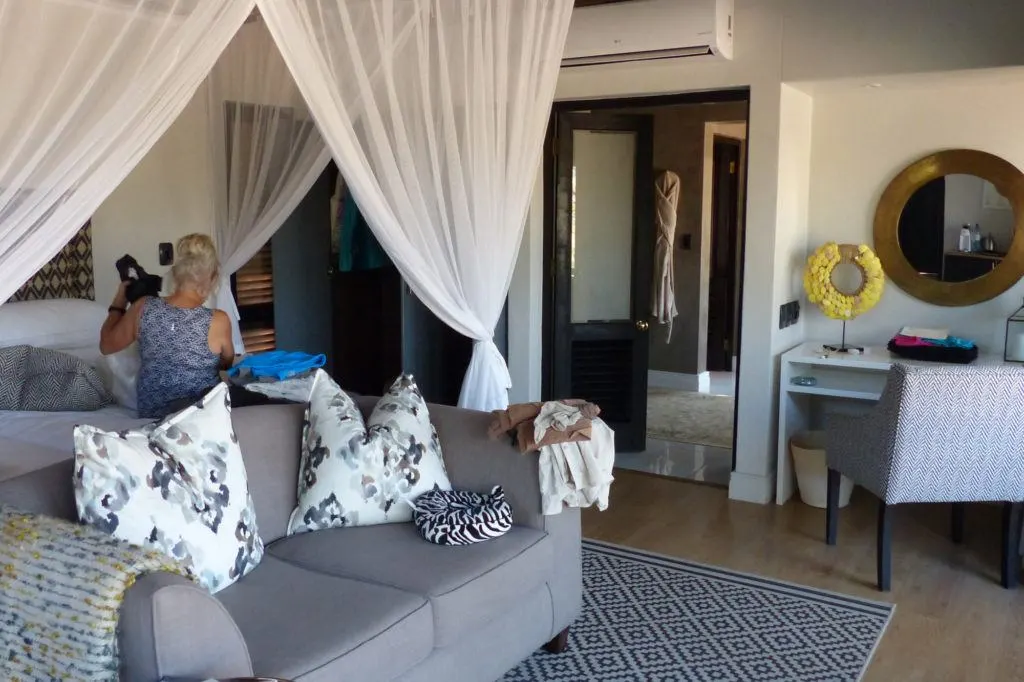
The Thornybush Game Lodge bungalows are large, plush, comfortable, and have everything you need. The lodge also provides an abundance of food and drink with three hearty meals each day and snacks in between.
The lodge food is really great with lots of dishes prepared using fruits and vegetables from local community gardens. This is another win for the game reserve because local growers sell their produce to the lodges and the lodge guests get wonderfully fresh food.


It’s expensive
Thornybush Game Lodge costs several hundred dollars per person per night, so it’s expensive. I’m normally a budget traveler, but I found it easy to rationalize the cost.
And it’s worth the price
The price includes a beautiful and spacious room, all of your food and drink, and two game drives each day. This is truly the adventure of a lifetime and well worth the cost.
The game lodges support the reserve and provide good jobs for the local people. The reserve also provides safe habitat for the animals and protects them from hunters and poachers. The animals are here in abundance and are free to go where they please.

Can You Visit Thornybush Game Lodge Without a Tour?
There were independent travelers, including families with children, at the lodge who had driven there on their own. There were also other lodges in the reserve that appeared much more rustic and are likely less expensive.

African Wildlife Safari Fun Facts
- Safari is a Swahili word and means journey.
- The dark vertical stripes on Impalas’ hindquarters resemble the letter “M.” The local joke is that “M” stands for McDonald’s because impalas are fast food for the big cats and wild dogs.
- White rhinos and black rhinos are the same color. Neither are white or black. One of their distinguishing features is the shape of their mouths. Black rhinos feed on leaves and twigs and have pointy lips to grab them. White rhinos graze on grass and have straight, wide mouths.
- Elephants push small trees and brush with their front feet to knock them down and then eat the bark from the branches. According to our Thornybush ranger/guide, bark is 80% of their food supply.
- Cape buffalo look harmless and laid back, but they are the most dangerous of all the African animals. They can be unpredictable and aggressive, and they kill more people than any other African animal.
- Leopards are lone, mostly nocturnal animals. The hunt at night and haul their prey up into a tree to eat. During the day, they often sleep in trees too. It’s pretty amazing to see them sleeping high up in trees straddling a limb with their legs dangling on either side.
- Lions are social and live in groups called “prides.” The females do most of the hunting. The males protect the pride and their territory. They spend most of their time just lounging around, playing, and sleeping.
- You can tell male and female giraffes by the hair on their horns. Females have hairy horns; males wear the hair off of their horns when they fight.
Practical Information
Getting There
If you are traveling independently, you can fly into Hoedspruit or Johannesburg and rent a car. If you have the means to arrange a private plane, there is an airstrip near the lodge.
I traveled on a tour with my Alumni group, so all of my transit and lodging arrangements were prearranged. Our tour flew from Cape Town to Hoedspruit and then traveled by van to Thornybush Game Lodge. The van ride took about an hour and much of it was on gravel roads.
Best Time to Go
I was in Thornybush in October, which is early spring, and it was perfect. It was never too hot and just cold enough for a jacket in the early morning and evening. The dry winter season was over and leaves were starting to grow on the trees and bushes.
Weather
The following average monthly high and low temperatures and number of rain days are for Kruger National Park (source), which is adjacent to Thornybush Game Reserve:
| Average | Jan | Feb | Mar | Apr | May | Jun | Jul | Aug | Sep | Oct | Nov | Dec |
| High (c) | 33 | 32 | 32 | 30 | 28 | 26 | 26 | 27 | 29 | 30 | 31 | 32 |
| Low (c) | 21 | 20 | 20 | 17 | 12 | 9 | 9 | 11 | 14 | 17 | 19 | 20 |
| Rainfall (days) | 7 | 7 | 6 | 3 | 2 | 1 | 1 | 1 | 2 | 4 | 6 | 7 |
What to Take on a South Africa Luxury Safari
You will want comfortable, casual clothes, your camera gear, and whatever toiletries and medicines you normally bring on a trip. Check the weather chart above to see what’s normal for the time of year you plan to go.
I went in October and it was mild, but was a bit cooler than I expected. It was chilly on the early morning game drives, so I wore my fleece and sometimes my windbreaker too. Even the ranger/guide always wore a jacket. I wish I had brought gloves too.
I needed gloves! I missed a great video opportunity when a pack of wild dogs ran past us. My hands were so cold I failed to push the video button all the way down.
Tips About Clothing
- Comfortable: This is essential. There’s no graceful way to climb into the back of a Safari Land Cruiser. To get in, you literally climb up the side.
- Convenient: Choose clothing with sun protection (SPF 50 is great) and, preferably, clothing that is hand washable and quick to dry.
- Colors: Safari sites recommend wearing neutral colors like khaki and olive green and avoid light, bright, and dark colors. The issue with light colors is that they show the dirt; the issue with bright and dark colors is that they can attract tsetse flies. I totally broke the color rules, but luckily, I never saw a tsetse fly.
Essentials to Take
- Fleece jacket
- Windbreaker (preferably waterproof, just in case it rains)
- Hat (one that provides sun protection and won’t fly off while riding in an open vehicle)
- Gloves (photographers gloves would be perfect)
- Long pants
- Shorts
- Long-sleeved SPF 50 shirts
- Kerchief/bandana (to wet and wrap around your neck in hot weather)
- Sunscreen
- Insect repellent or mosquito bracelets
- Soap packets for laundry
Other Things You Might Want
- Binoculars
- Swimsuit (the lodge has a pool)
- Pants with zip-off legs that convert to shorts
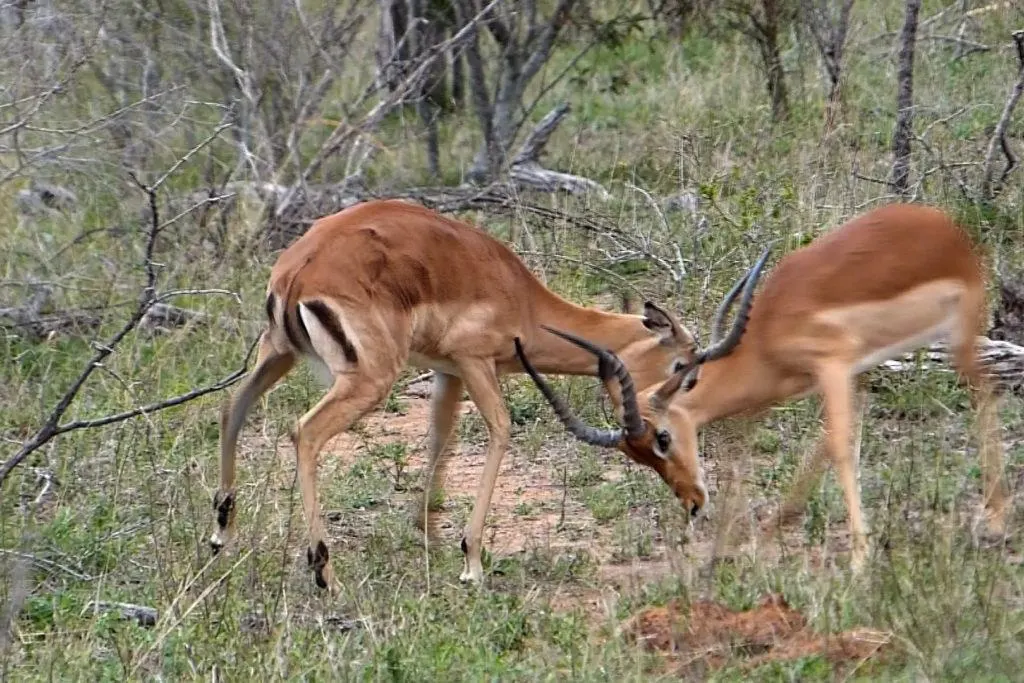
Note from Corinne: As you know, Jim and I have been on numerous self-drives and safaris in different parts of Africa. Check out these posts if you are interested in safaris in Botswana, Zambia, Madagascar, or Uganda.
Conclusion
One more really cool detail about Thornybush is that during every game drive, the ranger and tracker find a safe area in the bush to park and set up a spread of drinks and snacks. It’s a small, impromptu coffee break or cocktail party. So picture yourself out in the bush with a glass of wine watching a gorgeous African sunset — it’s pretty awesome.
Author bio: Ginny Vail is a travel writer, who loves sightseeing, photography, and videography. She’s been to 45 countries across six continents and traveled by air, car, bus, train, boat, and ship. Her articles can help you discover places to go, sights to see, and details about when and how to visit them.

Pin Thornybush Game Reserve for later planning!

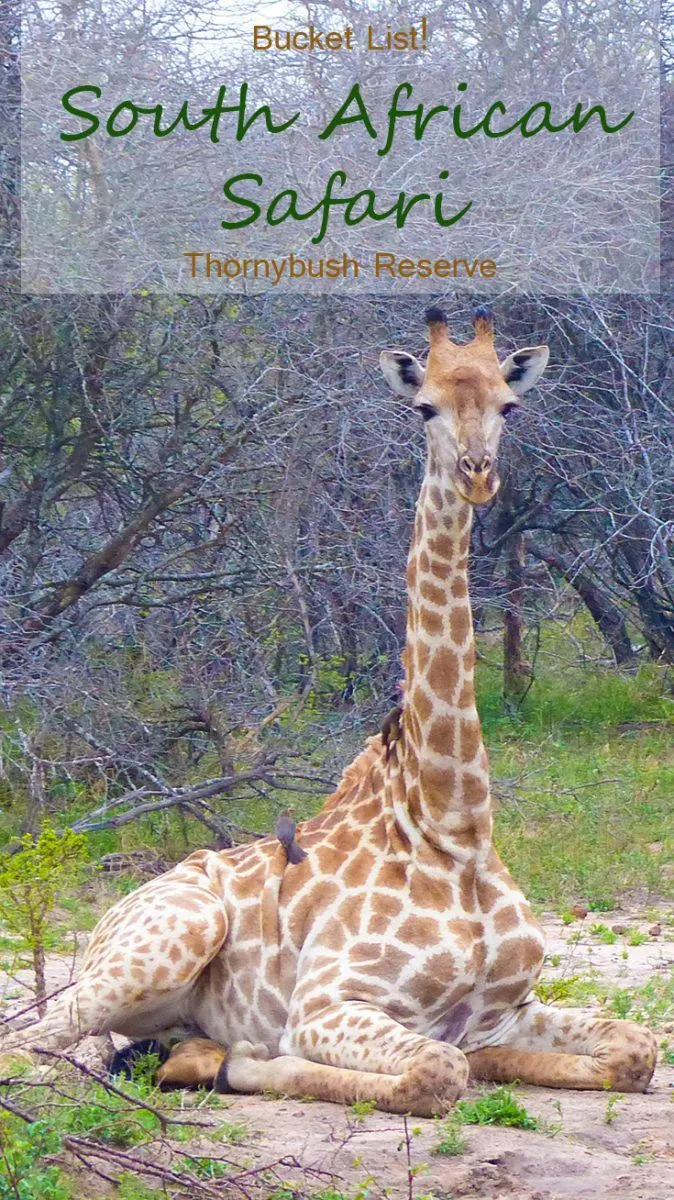







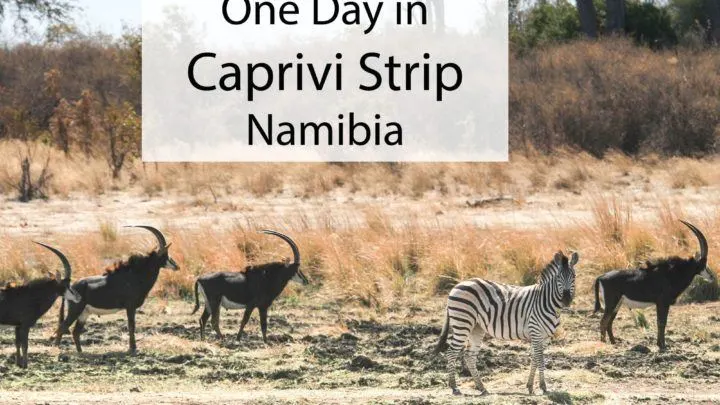
Ginny Vail
Saturday 25th of November 2017
Thank you Alphabeyond. I hope you have a great trip.
Kerri
Friday 24th of November 2017
The world seems to be in love with African safaris at the moment, us included. I am thinking of trying to do one next year so am hungrily devouring all info I can get as there are so many different parts of Africa and so many different experiences. This places looks incredible so it will definitely make my list of ones to check out more when I am ready.
Ginny Vail
Saturday 25th of November 2017
Kerri, thank you for your comment. If it’s not already on your list, check out Chobe National Park in Botswana also. I spent two days there and loved it, especially the boat cruises on the Chobe River. See Corinne’s post about Chobe’s swimming elephants.
100cobbledroads
Thursday 23rd of November 2017
Yet to get to Africa and see the big 5 on a safari. Seeing animals in their natural habitat reminds me of how complicated we have made our lives as humans. Don't you think so?
Ginny Vail
Saturday 25th of November 2017
Cobbledroads, thank you for commenting. I certainly agree that we've made out lives too complicated. Seeing the animals in their natural habitat makes that case and so does visiting places where you see beautiful, healthy, children who live in simple huts and have none of the trappings and toys we have, yet they laugh and play and seem very happy.
Lara Dunning
Wednesday 22nd of November 2017
I have not been on a safari but it is on my list as I so enjoy seeing animals in the environment they were born to be in. I didn't know there were wild dogs there, their colors are really cool!
Ginny Vail
Saturday 25th of November 2017
Lara, thank you for your comment. I didn't know about wild dogs either until I saw them at Thornybush. We saw them a second time while they were on a hunt. The whole pack ran right past us in single file. I was so excited to see them that I failed to push the video button on my camera and missed the shot. Their colors are very cool.
Sandy N Vyjay
Wednesday 22nd of November 2017
Your pictures and narratives have fueled my South Africa dreams. Saw some but not all of the big 5 in Rwanda East Africa. But South Africa is indeed the stuff that dreams are made of. The Thornybush sounds like a good company to embark on a safari.
Ginny Vail
Saturday 25th of November 2017
Sandy, thank you for your comment. You won't be disappointed if you visit the Thornybush reserve in South Africa. The rangers there really know how to provide a great experience for their visitors. I hadn't considered Rwanda; maybe it should be on my bucket list.